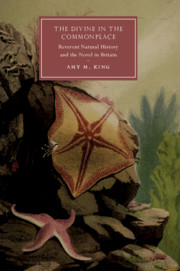Book contents
- The Divine in the Commonplace
- Cambridge Studies in Nineteenth-Century Literature and Culture
- The Divine in the Commonplace
- Copyright page
- Dedication
- Contents
- Figures
- Acknowledgments
- Introduction Natural History, the Theology of Nature, and the Novel
- Chapter 1 Reverent Natural History, the Sketch, and the Novel: Modes of English Realism in White, Mitford, and Austen
- Chapter 2 Early Victorian Natural History: Reverent Empiricism and the Aesthetic of the Commonplace
- Chapter 3 The Formal Realism of Reverent Natural History: Tide-pools, Aquaria, and the Seashore Natural Histories of P. H. Gosse and G. H. Lewes
- Chapter 4 Reverence at the Seashore: Seashore Natural History, Charles Kingsley’s Two Years Ago (1857), and Margaret Gatty’s Parables from Nature (1855)
- Chapter 5 Seeing the Divine in the Commonplace: George Eliot’s Paranaturalist Realism (1856–1859)
- Chapter 6 Elizabeth Gaskell’s Everyday: Reverent Form and Natural Theology in Sylvia’s Lovers (1863) and Wives and Daughters (1866)
- Epilogue Barsetshire via Selborne: Anthony Trollope’s The Last Chronicle of Barset (1867)
- Notes
- Bibliography
- Index
- Cambridge Studies in Nineteenth-Century Literature and Culture
Chapter 2 - Early Victorian Natural History: Reverent Empiricism and the Aesthetic of the Commonplace
Published online by Cambridge University Press: 06 July 2019
- The Divine in the Commonplace
- Cambridge Studies in Nineteenth-Century Literature and Culture
- The Divine in the Commonplace
- Copyright page
- Dedication
- Contents
- Figures
- Acknowledgments
- Introduction Natural History, the Theology of Nature, and the Novel
- Chapter 1 Reverent Natural History, the Sketch, and the Novel: Modes of English Realism in White, Mitford, and Austen
- Chapter 2 Early Victorian Natural History: Reverent Empiricism and the Aesthetic of the Commonplace
- Chapter 3 The Formal Realism of Reverent Natural History: Tide-pools, Aquaria, and the Seashore Natural Histories of P. H. Gosse and G. H. Lewes
- Chapter 4 Reverence at the Seashore: Seashore Natural History, Charles Kingsley’s Two Years Ago (1857), and Margaret Gatty’s Parables from Nature (1855)
- Chapter 5 Seeing the Divine in the Commonplace: George Eliot’s Paranaturalist Realism (1856–1859)
- Chapter 6 Elizabeth Gaskell’s Everyday: Reverent Form and Natural Theology in Sylvia’s Lovers (1863) and Wives and Daughters (1866)
- Epilogue Barsetshire via Selborne: Anthony Trollope’s The Last Chronicle of Barset (1867)
- Notes
- Bibliography
- Index
- Cambridge Studies in Nineteenth-Century Literature and Culture
Summary
Chapter 2 considers early Victorian natural history in monograph and periodical form, tracing the growing importance of Gilbert White as a foundational example for early nineteenth-century natural history. The persistence of the theology of nature creates an “aesthetic of the commonplace” in the early Victorian moment. Natural histories focused on nature’s most quotidian aspects and were shot through with religious reverence for the natural world; the chapter demonstrates that they were a mode of realism that relied upon reverent empiricism to capture the truths they sought to represent. Reverent natural histories demonstrated the wonder in the everyday (especially small, commonplace, or insignificant) natural object. The chapter focuses on natural history monographs from the 1830s and two common object texts from the 1850s by James Drummond, Edward Jesse, J. L. Knapp, Rev. J. G. Wood, and Anne Pratt. The second half of the chapter focuses on natural history from The Saturday Magazine and The Penny Magazine in the 1830s and 1840s.
Keywords
- Type
- Chapter
- Information
- The Divine in the CommonplaceReverent Natural History and the Novel in Britain, pp. 89 - 111Publisher: Cambridge University PressPrint publication year: 2019



